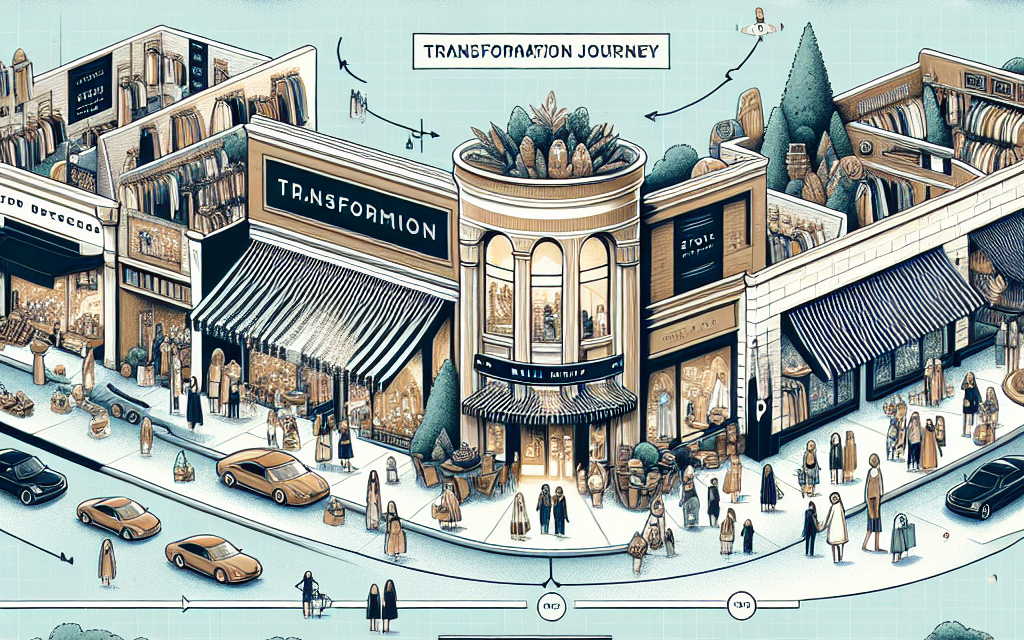“Reviving Elegance: The Gordon Brothers’ Visionary Path to a $750 Million Laura Ashley Renaissance.”
Introduction
“Transforming Laura Ashley: The Gordon Brothers’ Journey to a $750 Million Empire” chronicles the remarkable story of how the Gordon brothers revitalized the iconic British brand Laura Ashley. Facing significant challenges in a rapidly changing retail landscape, they implemented innovative strategies that not only restored the brand’s heritage but also expanded its market reach. Through a combination of savvy business acumen, a deep understanding of consumer trends, and a commitment to quality, the Gordons transformed Laura Ashley into a thriving enterprise, ultimately achieving a valuation of $750 million. This narrative highlights their entrepreneurial spirit, resilience, and the transformative power of strategic vision in the world of fashion and home decor.
The Rise of Gordon Brothers: A New Era for Laura Ashley
The transformation of Laura Ashley into a thriving enterprise under the stewardship of Gordon Brothers marks a significant chapter in the brand’s storied history. Founded in 1953, Laura Ashley became synonymous with quintessential British design, characterized by floral patterns and vintage aesthetics. However, by the early 2000s, the company faced considerable challenges, including financial difficulties and a declining market presence. It was during this tumultuous period that Gordon Brothers, a global advisory, restructuring, and investment firm, stepped in to revitalize the brand and steer it toward a new era of growth.
Gordon Brothers recognized the intrinsic value of Laura Ashley’s heritage and its loyal customer base. They understood that the brand’s identity was deeply rooted in its history, which provided a solid foundation for revitalization. By leveraging their expertise in brand management and retail strategy, the firm embarked on a comprehensive assessment of Laura Ashley’s operations. This involved a meticulous analysis of the product lines, market positioning, and consumer preferences. Through this process, they identified key areas for improvement, including the need for a more modernized product offering that would resonate with contemporary consumers while still honoring the brand’s classic roots.
One of the first steps taken by Gordon Brothers was to streamline the product range. By focusing on core collections that encapsulated the essence of Laura Ashley, they aimed to enhance brand clarity and appeal. This strategic consolidation allowed for a more efficient supply chain and improved inventory management, ultimately leading to cost savings. Furthermore, the firm invested in innovative design initiatives, collaborating with talented designers to create fresh, modern interpretations of Laura Ashley’s iconic styles. This blend of tradition and innovation not only attracted a new generation of customers but also rekindled interest among long-time fans of the brand.
In addition to product revitalization, Gordon Brothers placed a strong emphasis on enhancing the customer experience. They recognized that the retail landscape was evolving, with consumers increasingly seeking immersive shopping experiences. To address this shift, they revamped Laura Ashley’s physical stores, transforming them into inviting spaces that showcased the brand’s aesthetic while providing a warm and welcoming atmosphere. This included thoughtful merchandising strategies and engaging visual displays that highlighted the beauty of the products. Simultaneously, they invested in digital transformation, enhancing the brand’s online presence and e-commerce capabilities. By creating a seamless omnichannel experience, they ensured that customers could engage with Laura Ashley in a manner that suited their preferences.
As a result of these strategic initiatives, Laura Ashley began to regain its footing in the competitive retail market. The brand’s renewed focus on quality, design, and customer engagement resonated with consumers, leading to increased sales and a revitalized brand image. Gordon Brothers’ commitment to sustainable practices also played a crucial role in appealing to environmentally conscious shoppers, further solidifying Laura Ashley’s position in the market.
In conclusion, the rise of Gordon Brothers as a transformative force for Laura Ashley illustrates the power of strategic vision and effective execution. By honoring the brand’s heritage while embracing modernity, they have successfully navigated the complexities of the retail landscape. The journey from a struggling brand to a $750 million empire is a testament to the potential for revitalization when innovative thinking and a deep understanding of consumer needs converge. As Laura Ashley continues to evolve, it stands as a beacon of resilience and adaptability in an ever-changing market.
Strategic Rebranding: Revitalizing Laura Ashley’s Image
The journey of transforming Laura Ashley into a revitalized brand under the stewardship of the Gordon Brothers is a compelling narrative of strategic rebranding that has significantly altered the company’s trajectory. Initially founded in 1953, Laura Ashley became synonymous with floral patterns and quintessentially British home decor. However, by the early 2000s, the brand faced challenges that threatened its relevance in a rapidly evolving retail landscape. Recognizing the need for a comprehensive rebranding strategy, the Gordon Brothers embarked on a mission to breathe new life into the iconic label.
To begin with, the Gordon Brothers conducted an extensive analysis of the brand’s existing image and market position. They identified that while Laura Ashley had a rich heritage, its appeal had waned among younger consumers who were increasingly drawn to modern aesthetics. This realization prompted a strategic pivot aimed at redefining the brand’s identity. By focusing on contemporary design elements while retaining the essence of its classic roots, the Gordon Brothers sought to create a bridge between nostalgia and modernity. This dual approach not only aimed to attract a new demographic but also to re-engage loyal customers who had drifted away.
In addition to refreshing the product line, the Gordon Brothers recognized the importance of enhancing the overall customer experience. They implemented a multi-channel retail strategy that integrated both online and offline platforms. This move was crucial, as it allowed Laura Ashley to reach a broader audience while providing a seamless shopping experience. The introduction of an updated e-commerce platform, coupled with a revitalized in-store experience, ensured that customers could engage with the brand in a manner that suited their preferences. By prioritizing customer engagement, the Gordon Brothers effectively positioned Laura Ashley as a brand that values its consumers and understands their evolving needs.
Moreover, the rebranding effort extended beyond product offerings and customer experience; it also encompassed a renewed focus on sustainability. In an era where consumers are increasingly conscious of environmental impact, the Gordon Brothers made it a priority to incorporate sustainable practices into the brand’s operations. This included sourcing materials responsibly and promoting eco-friendly products. By aligning Laura Ashley with sustainability, the brand not only appealed to environmentally conscious consumers but also positioned itself as a forward-thinking entity in the home decor market.
As the rebranding strategy unfolded, the Gordon Brothers also invested in marketing initiatives that highlighted the brand’s heritage while showcasing its modern evolution. Through targeted advertising campaigns and collaborations with contemporary designers, they successfully communicated the message that Laura Ashley is not merely a relic of the past but a dynamic brand capable of adapting to current trends. This strategic narrative was essential in reshaping public perception and reigniting interest in the brand.
Ultimately, the transformation of Laura Ashley under the Gordon Brothers’ leadership exemplifies the power of strategic rebranding. By thoughtfully blending tradition with innovation, enhancing customer engagement, and committing to sustainability, they have revitalized the brand’s image and positioned it for future growth. As a result, Laura Ashley has not only regained its footing in the competitive retail landscape but has also emerged as a $750 million empire, demonstrating that with the right vision and execution, even legacy brands can thrive in a modern marketplace. This journey serves as a testament to the importance of adaptability and strategic foresight in the ever-changing world of retail.
Financial Turnaround: From Struggles to $750 Million Success
The financial turnaround of Laura Ashley, a brand synonymous with British design and home furnishings, is a remarkable story of resilience and strategic vision. Once a thriving name in the textile and home decor industry, Laura Ashley faced significant challenges that threatened its very existence. However, the intervention of the Gordon Brothers marked a pivotal moment in the company’s trajectory, transforming it from the brink of collapse to a flourishing enterprise valued at $750 million.
Initially, Laura Ashley struggled with declining sales and mounting debts, a situation exacerbated by changing consumer preferences and increased competition in the retail sector. The brand, which had built its reputation on floral patterns and quintessentially British aesthetics, found itself at a crossroads. As the market evolved, the company’s inability to adapt to contemporary trends led to a loss of relevance among consumers. This decline was not merely a reflection of poor management but also indicative of broader shifts in the retail landscape, where online shopping began to dominate and traditional brick-and-mortar stores faced unprecedented challenges.
Recognizing the potential for revitalization, the Gordon Brothers, a firm known for its expertise in asset management and financial restructuring, stepped in to assess the situation. Their approach was methodical and data-driven, focusing on identifying the core strengths of the Laura Ashley brand while simultaneously addressing its weaknesses. The Gordon Brothers understood that the essence of Laura Ashley lay in its heritage and design ethos, which could be leveraged to reconnect with both loyal customers and new audiences.
To initiate the turnaround, the Gordon Brothers implemented a comprehensive restructuring plan that involved streamlining operations and optimizing the supply chain. By reducing overhead costs and improving inventory management, they were able to enhance profitability without compromising the quality that Laura Ashley was known for. Furthermore, they recognized the importance of digital transformation in today’s retail environment. By investing in e-commerce capabilities and enhancing the brand’s online presence, they positioned Laura Ashley to reach a broader customer base, thus driving sales growth.
In addition to operational improvements, the Gordon Brothers focused on revitalizing the brand’s image. They launched targeted marketing campaigns that highlighted Laura Ashley’s unique design heritage while also showcasing contemporary collections that appealed to modern consumers. This dual approach not only attracted a new demographic but also reignited interest among long-time fans of the brand. The strategic emphasis on storytelling and emotional connection resonated with consumers, fostering brand loyalty and encouraging repeat purchases.
As a result of these concerted efforts, Laura Ashley experienced a remarkable turnaround. The company not only stabilized its financial position but also achieved significant growth, culminating in a valuation of $750 million. This success story serves as a testament to the power of strategic intervention and the importance of adaptability in an ever-changing market. The Gordon Brothers’ journey with Laura Ashley exemplifies how a combination of financial acumen, operational efficiency, and brand revitalization can lead to extraordinary outcomes.
In conclusion, the transformation of Laura Ashley from a struggling entity to a $750 million empire underscores the potential for recovery in the face of adversity. The Gordon Brothers’ strategic vision and execution not only salvaged a beloved brand but also set a precedent for future endeavors in the retail sector. Their journey illustrates that with the right approach, even the most challenged companies can find a path to success and sustainability.
Innovative Design Strategies: Modernizing Laura Ashley Collections
The transformation of Laura Ashley into a modern retail powerhouse is a testament to the innovative design strategies employed by the Gordon Brothers. Recognizing the brand’s rich heritage, the Gordon Brothers sought to modernize Laura Ashley’s collections while preserving the essence that made it a beloved name in home furnishings and fashion. This delicate balance between tradition and contemporary appeal has been pivotal in revitalizing the brand and expanding its market reach.
To begin with, the Gordon Brothers implemented a comprehensive analysis of consumer trends and preferences. By leveraging data analytics, they identified shifts in customer demographics and purchasing behaviors, which informed their design strategies. This data-driven approach allowed them to pinpoint the styles and patterns that resonated with modern consumers, ensuring that new collections would not only attract loyal customers but also appeal to a younger audience. Consequently, the introduction of fresh, vibrant color palettes and innovative fabric choices became a hallmark of the revamped collections.
Moreover, the Gordon Brothers recognized the importance of sustainability in contemporary design. As consumers increasingly prioritize eco-friendly products, they integrated sustainable practices into the design and production processes. This commitment to sustainability not only enhanced the brand’s appeal but also aligned with the values of a growing segment of environmentally conscious consumers. By utilizing organic materials and implementing responsible sourcing practices, Laura Ashley positioned itself as a forward-thinking brand that respects both tradition and the planet.
In addition to sustainability, the Gordon Brothers emphasized versatility in their design strategies. Understanding that modern consumers seek multifunctional products, they introduced collections that could seamlessly transition from casual to formal settings. This adaptability was reflected in the design of furniture and home accessories, which featured clean lines and timeless aesthetics, allowing them to fit into various interior styles. By focusing on versatility, Laura Ashley’s collections became more relevant to consumers’ diverse lifestyles, ultimately driving sales and enhancing brand loyalty.
Furthermore, the Gordon Brothers embraced technology as a means to enhance the design process. By incorporating advanced design software and virtual reality tools, they were able to visualize and prototype new collections more efficiently. This technological integration not only streamlined the design process but also fostered greater collaboration among designers, enabling them to experiment with innovative concepts and materials. As a result, the collections became more dynamic and reflective of current design trends, appealing to a broader audience.
In addition to these strategies, the Gordon Brothers also prioritized customer engagement through social media and digital marketing. By creating interactive platforms for consumers to share their experiences and preferences, they fostered a sense of community around the brand. This engagement not only provided valuable insights into consumer desires but also allowed Laura Ashley to showcase its modernized collections in a relatable and accessible manner. The use of social media influencers further amplified this reach, introducing the brand to new audiences and enhancing its visibility in a competitive market.
Ultimately, the innovative design strategies employed by the Gordon Brothers have played a crucial role in modernizing Laura Ashley’s collections. By blending tradition with contemporary sensibilities, prioritizing sustainability, embracing technology, and fostering customer engagement, they have successfully transformed the brand into a $750 million empire. This journey underscores the importance of adaptability and innovation in the ever-evolving landscape of retail, ensuring that Laura Ashley remains a relevant and cherished name for generations to come.
Market Expansion: Reaching New Audiences with Laura Ashley
The journey of Laura Ashley, a brand synonymous with quintessential British design, has undergone a remarkable transformation under the stewardship of the Gordon Brothers. As they sought to revitalize the brand, one of their primary strategies was market expansion, aimed at reaching new audiences and reinvigorating the company’s presence in a competitive landscape. This approach not only involved geographical diversification but also a reimagining of the brand’s product offerings to appeal to a broader demographic.
Initially, the Gordon Brothers recognized that Laura Ashley’s traditional customer base, while loyal, was not sufficient to sustain the brand’s growth in an evolving market. To address this challenge, they embarked on a comprehensive analysis of consumer trends and preferences. This research revealed a significant opportunity to attract younger consumers who were increasingly drawn to home décor and fashion that reflected their personal style. By modernizing the brand’s aesthetic while retaining its core values, the Gordon Brothers aimed to create a bridge between the classic designs that had defined Laura Ashley and the contemporary tastes of a new generation.
In addition to refreshing the product line, the Gordon Brothers strategically expanded Laura Ashley’s geographical footprint. They identified key international markets where the brand’s heritage and design ethos could resonate with consumers. By entering markets in Asia and North America, they not only increased brand visibility but also tapped into burgeoning consumer bases eager for quality home furnishings and fashion. This international expansion was complemented by a robust online presence, allowing Laura Ashley to reach customers beyond traditional retail channels. The integration of e-commerce platforms enabled the brand to engage with a global audience, providing convenience and accessibility that modern consumers demand.
Moreover, the Gordon Brothers understood the importance of collaboration in enhancing brand appeal. They sought partnerships with influencers and designers who could introduce Laura Ashley to new audiences through innovative marketing campaigns. These collaborations not only revitalized the brand’s image but also fostered a sense of community among consumers, encouraging them to share their own interpretations of Laura Ashley’s designs. This grassroots marketing approach proved effective in generating buzz and excitement around the brand, further solidifying its relevance in a fast-paced market.
As the brand expanded its reach, the Gordon Brothers also placed a strong emphasis on sustainability, recognizing that modern consumers are increasingly concerned about the environmental impact of their purchases. By incorporating sustainable practices into the production process and sourcing materials responsibly, Laura Ashley positioned itself as a forward-thinking brand that aligns with the values of its target audience. This commitment to sustainability not only enhanced the brand’s reputation but also attracted environmentally conscious consumers who are willing to invest in products that reflect their values.
In conclusion, the market expansion strategy employed by the Gordon Brothers has been instrumental in transforming Laura Ashley into a $750 million empire. By reaching new audiences through geographical diversification, product innovation, strategic partnerships, and a commitment to sustainability, they have successfully revitalized a storied brand for a new era. As Laura Ashley continues to evolve, it stands as a testament to the power of adaptability and vision in the ever-changing landscape of retail. The journey of transformation is ongoing, but the foundation laid by the Gordon Brothers promises a bright future for this iconic brand.
Sustainability Initiatives: Transforming Laura Ashley for the Future
In recent years, sustainability has emerged as a critical focus for businesses across various sectors, and Laura Ashley, a brand synonymous with British heritage and design, is no exception. Under the stewardship of the Gordon Brothers, the company has embarked on a transformative journey aimed at not only revitalizing its product offerings but also ensuring that its operations align with contemporary environmental standards. This commitment to sustainability is not merely a trend; it represents a fundamental shift in how Laura Ashley approaches its business model, reflecting a growing awareness of the ecological impact of the fashion and home décor industries.
To begin with, the Gordon Brothers have prioritized the integration of sustainable materials into Laura Ashley’s product lines. This initiative involves sourcing organic cotton, recycled polyester, and other eco-friendly fabrics that reduce the environmental footprint of the manufacturing process. By opting for materials that are less harmful to the planet, the company is not only appealing to a more environmentally conscious consumer base but also setting a precedent for responsible sourcing within the industry. This strategic move is indicative of a broader trend where brands are increasingly held accountable for their environmental practices, and Laura Ashley is keen to position itself as a leader in this regard.
Moreover, the Gordon Brothers have recognized the importance of transparency in the supply chain. By implementing rigorous standards for ethical sourcing and production, Laura Ashley is working to ensure that its suppliers adhere to sustainable practices. This commitment extends beyond mere compliance; it involves fostering long-term relationships with suppliers who share the brand’s vision for sustainability. As a result, consumers can feel confident that their purchases contribute to a more sustainable future, reinforcing brand loyalty and trust.
In addition to material sourcing and supply chain transparency, the Gordon Brothers have also focused on reducing waste throughout the production process. By adopting lean manufacturing techniques and optimizing inventory management, Laura Ashley aims to minimize excess production and reduce the amount of waste generated. This approach not only enhances operational efficiency but also aligns with the principles of a circular economy, where products are designed with their end-of-life in mind. By prioritizing durability and recyclability, Laura Ashley is taking significant steps toward reducing its overall environmental impact.
Furthermore, the company is actively engaging with its customers to promote sustainable practices. Through educational campaigns and initiatives, Laura Ashley encourages consumers to make informed choices about their purchases. This includes promoting the idea of investing in timeless, high-quality pieces that can withstand changing trends, thereby reducing the frequency of purchases and the associated environmental costs. By fostering a culture of sustainability among its customer base, Laura Ashley is not only enhancing its brand image but also contributing to a larger movement toward responsible consumption.
As the Gordon Brothers continue to steer Laura Ashley into a new era, their commitment to sustainability is evident in every facet of the business. From sourcing materials to engaging with consumers, the brand is redefining its identity in a way that resonates with modern values. This transformation is not just about adapting to market demands; it is about embracing a holistic approach to business that prioritizes the health of the planet. In doing so, Laura Ashley is not only securing its place in the competitive landscape but also paving the way for a more sustainable future, one that honors its rich heritage while looking forward to the challenges and opportunities that lie ahead.
Lessons Learned: Key Takeaways from the Gordon Brothers’ Journey
The journey of the Gordon Brothers in transforming Laura Ashley into a $750 million empire offers a wealth of insights that can be applied across various industries. One of the most significant lessons learned from their experience is the importance of adaptability in a rapidly changing market. The retail landscape has undergone profound shifts, particularly with the rise of e-commerce and changing consumer preferences. The Gordon Brothers recognized early on that to thrive, they needed to pivot from traditional retail strategies to embrace digital platforms. This adaptability not only allowed them to reach a broader audience but also enabled them to respond swiftly to market demands, ensuring that Laura Ashley remained relevant in a competitive environment.
Moreover, the Gordon Brothers demonstrated the value of a strong brand identity. They understood that Laura Ashley was not merely a retail chain but a brand steeped in heritage and emotional connection with its customers. By focusing on the brand’s core values and aesthetic, they were able to revitalize its image while maintaining the essence that loyal customers cherished. This approach highlights the necessity of balancing innovation with tradition, as it is crucial for businesses to evolve without alienating their existing customer base. The Gordon Brothers’ commitment to preserving the brand’s legacy while modernizing its offerings serves as a reminder that successful transformation often requires a delicate equilibrium.
In addition to adaptability and brand identity, the Gordon Brothers’ journey underscores the significance of strategic partnerships. Recognizing that they could not achieve their ambitious goals in isolation, they sought collaborations that would enhance their operational capabilities and market reach. By forging alliances with key stakeholders, including suppliers and technology partners, they were able to streamline processes and improve efficiency. This collaborative approach not only facilitated growth but also fostered a culture of innovation, as diverse perspectives contributed to more robust decision-making. The lesson here is clear: in today’s interconnected world, leveraging partnerships can be a powerful catalyst for success.
Furthermore, the Gordon Brothers exemplified the importance of data-driven decision-making. In an era where information is abundant, they utilized analytics to gain insights into consumer behavior, inventory management, and market trends. This reliance on data allowed them to make informed choices that minimized risks and maximized opportunities. By prioritizing data in their strategic planning, they were able to anticipate shifts in consumer preferences and adjust their offerings accordingly. This lesson emphasizes that in a data-rich environment, businesses must harness the power of analytics to stay ahead of the curve.
Lastly, the Gordon Brothers’ experience illustrates the critical role of leadership in driving transformation. Their vision and determination were instrumental in navigating the complexities of revitalizing Laura Ashley. Effective leadership not only inspires teams but also fosters a culture of resilience and innovation. The Gordon Brothers demonstrated that strong leadership is characterized by clear communication, a shared vision, and the ability to motivate others toward common goals. This aspect of their journey serves as a reminder that successful transformation is often rooted in the strength of its leaders.
In conclusion, the Gordon Brothers’ journey with Laura Ashley offers invaluable lessons in adaptability, brand identity, strategic partnerships, data-driven decision-making, and leadership. These key takeaways provide a roadmap for businesses seeking to navigate the challenges of transformation in an ever-evolving marketplace. By embracing these principles, organizations can position themselves for sustainable growth and success in the future.
Q&A
1. **What is the main focus of “Transforming Laura Ashley”?**
– The book focuses on the journey of the Gordon Brothers in revitalizing the Laura Ashley brand and turning it into a $750 million empire.
2. **Who are the Gordon Brothers?**
– The Gordon Brothers are a family of entrepreneurs known for their expertise in brand management and retail, particularly in the context of reviving struggling companies.
3. **What challenges did the Gordon Brothers face with Laura Ashley?**
– They faced challenges such as declining sales, outdated brand perception, and the need to modernize the product line while retaining the brand’s heritage.
4. **What strategies did the Gordon Brothers implement to transform Laura Ashley?**
– They focused on rebranding, expanding product offerings, enhancing customer experience, and leveraging e-commerce to reach a broader audience.
5. **How did the Gordon Brothers address the brand’s heritage?**
– They maintained key elements of Laura Ashley’s design aesthetic while updating the product range to appeal to contemporary consumers.
6. **What was the outcome of the transformation?**
– The transformation led to significant revenue growth, positioning Laura Ashley as a competitive player in the home furnishings and fashion markets.
7. **What lessons can be learned from the Gordon Brothers’ journey?**
– Key lessons include the importance of understanding brand identity, adapting to market trends, and the value of strategic innovation in revitalizing a legacy brand.
Conclusion
The transformation of Laura Ashley under the guidance of the Gordon Brothers exemplifies a strategic blend of innovation, brand revitalization, and market adaptation. By leveraging their expertise in retail and understanding consumer trends, the Gordons successfully repositioned the brand, leading to significant financial growth and the establishment of a $750 million empire. Their journey highlights the importance of visionary leadership and the ability to navigate challenges in a competitive landscape, ultimately reinvigorating a classic brand for modern consumers.





